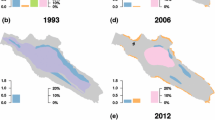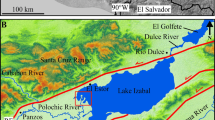Abstract
Eichhornia crassipes and Salvinia molesta, both notorious weeds, are present in the catchment of Cabora Bassa, a new man-made lake on the Zambezi River, Moçambique.
Weed dispersal, controlled by wind and current (and indirectly by rate of lake filling and lake morphology) culminated in the distribution of mats in the eastern and western extremities with very small cover in central lake areas. Eichhornia offset production was initially very rapid later diminishing markedly with many plants showing symptoms o: nutrient deficiency. Eichhornia completely dominated mat composition at the end of the year whilst Salvinia cover was negligible.
Heavy drawdown in the middle of the year lead to destruction of nearly 50% of the weed mats. Whilst pre-drawdown levels were attained by the end of the year, there was no evidence for expected explosive population growth and extensive weed colonization in the filling phase.
Similar content being viewed by others
References
Begg, G. W. 1970. Limnological observations on Lake Kariba during 1967 with emphasis on some special features. Limnol. Oceanogr. 25: 776–788.
Bennett, F. D. 1974. Biological control, 99–106, in Aquatic Vegetation and its use and control edited by D. S. Mitchell, Unesco.
Bock, J. H. 1966. An ecological study of Eichhornia crassipes with special emphasis on its reproductive biology. Ph. D. Thesis, Univ. California, Berkeley.
Bock, J. H. 1969. Productivity of the Water Hyacinth, Eichhornia crassipes (Mart) Solms. Ecology. 50: 461–4.
Bond, W. J., Coe, N., Jackson, P. N. B. & Rogers, K. H. (in press). The limnology of Cabora Bassa, Moçambique, during its first year. Freshwater Biology.
Bowmaker, A. P. 1973. Hydrophyte dynamics in Mwenda Bay, Lake Kariba. Kariba Studies. 3: 42–59.
Davies, B. R., Hall, A. & Jackson, P. N. B. 1975. Some ecological aspects of the Cabora Bassa Dam. Biol. Conserv. 8: 189–201.
Hall, A., Davies, B. R. & Valente, I. 1976. Cabora Bassa: some preliminary physico-chemical and zooplankton pre-impoundment results. Hydrobiologia (48) 1: 17–25.
Harding, D. 1966. Lake Kariba, The hydrology and development of fisheries, in Man-Made Lakes, edited by R. H. Lowe-McConnell, 7–20 Academic, London.
Hidrotecnica Portugesa 1973. Instalacoes para navegacao na Albufeira de Cabora Bassa. Tomo 4. Gabinete do Piano do Zambeze, Lisboa.
Jackson, P. B. N. & Davies, B. R. 1976. Cabora Bassa in its first year: some ecological aspects and comparisons. Rhodesia Science News. 10, No 5: 128–133.
Lingen, M. I. van der 1973. Lake Kariba: Early History and South Shore 132–142, in Man-Made Lakes: Their Problems and Environmental Effects edited by W. C. Ackermann, G. F. White and E. B. Worthington. American Geophysical Union, Washington, D.C.
Little, E. C. S. 1966. The invasion of man-made lakes by plants, in Man-Made Lakes, edited by R. H. Lowe-McConnell, 75–86, Academic, London.
Macedo, J. de Aguiar 1974. Vegetacao aquatica em Cabora Bassa. Instituto de investigacao agronomica de Moçambique. Memorias No. 5.
Mitchell, D. S. 1970. Autoecological studies of Salvinia auriculata Aubl., Ph. D. thesis, Univ. of London.
Mitchell, D. S. 1973. Aquatic weeds in Man-Made Lakes, 606–611, in Man-Made Lakes: Their Problems and Environmental Effects, edited by W. C. Ackermann, G. F. White and E. B. Worthington. American Geophysical Union, Washington, D.C.
Mitchell, D. S. 1974. Editor, Aquatic Vegetation and its Use and Control. Unesco, Paris.
Mitchell, D. S. & Tur, N. M. 1975. The rate of growth of Salvinia molesta (S. auriculata Auct.), in Laboratory and natural conditions. J. Appl. Ecol. 12: 213–225.
Musil, C. F. & Breen, C. M. 1977. The application of growth kinetics to the control of Eichhornia crassipes through nutrient removal by chemical harvesting. Hydrobiologia. 53, 2: 167–171.
Oliveira, J. S. 1972. ‘Zimofolia’ Um novo alimento levedurizada. An. Inst. Sup. Agron., Lisbon. 32: 21–36.
Parija, P. 1934. Physiological investigations on water hyacinth (Eichhornia crassipes) in Orisa with notes on some other aquatic weeds. Indian J. Agric. Science 4 (3): 399–429.
Penfound, T. T. & Earle, W. T. 1948. The biology of the water hyacinth. Ecol. Monogr. 18: 447–72.
Perkins, B. D. 1972. Potential for Waterhyacinth Management with biological agents. Procedings Annual Tall Timbers Conference on Ecological Animal Control by Habitat Management, 53–64.
Author information
Authors and Affiliations
Rights and permissions
About this article
Cite this article
Bond, W.J., Roberts, M.G. The colonization of Cabora Bassa, Moçambique, a new man-made lake, by floating aquatic macrophytes. Hydrobiologia 60, 243–259 (1978). https://doi.org/10.1007/BF00011719
Received:
Published:
Issue Date:
DOI: https://doi.org/10.1007/BF00011719




